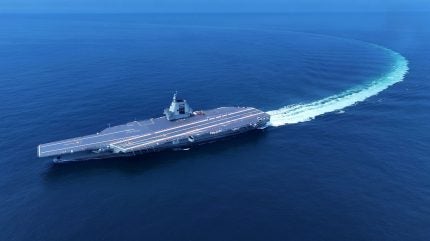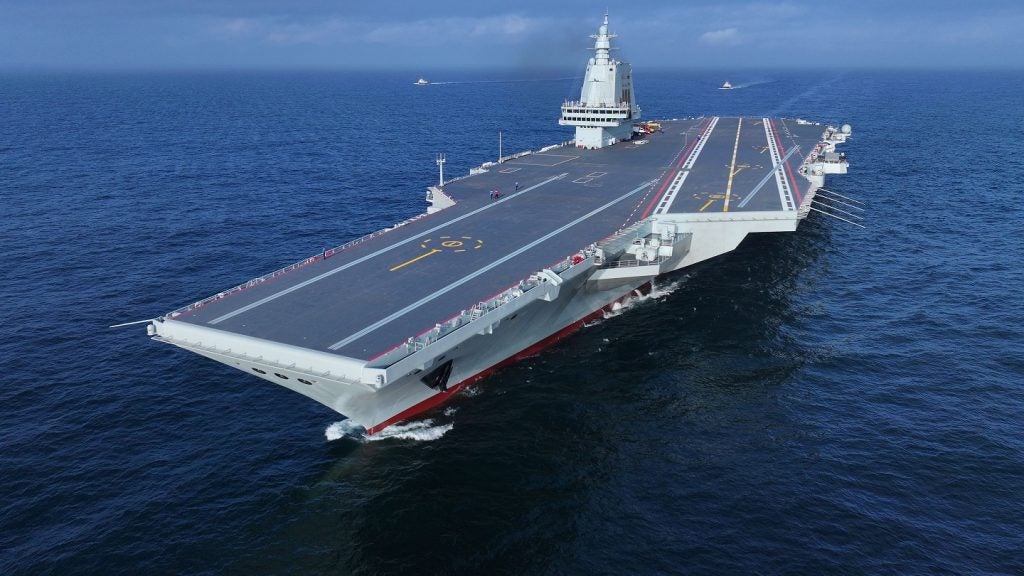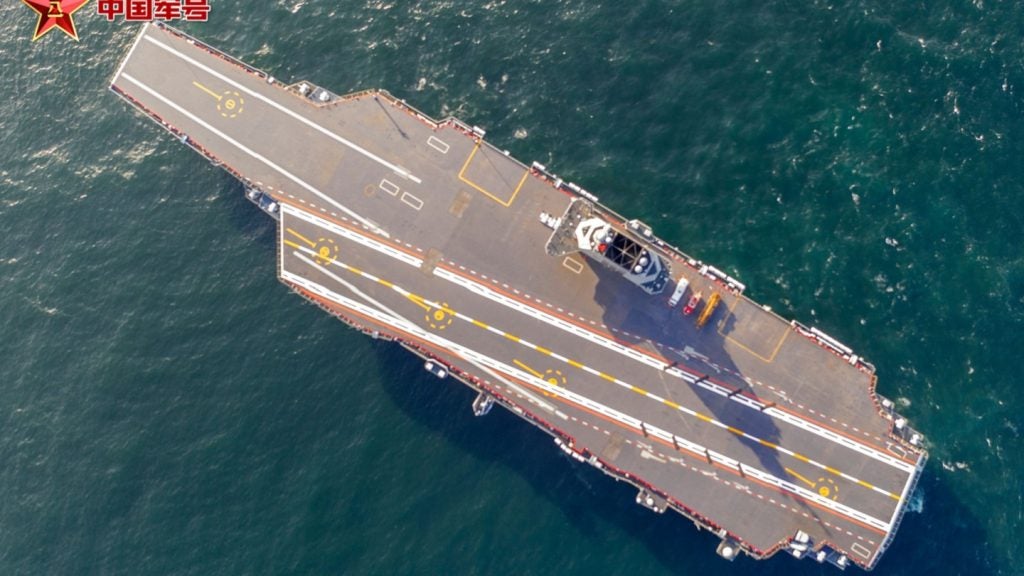
Newly released images of China’s new aircraft carrier undertaking sea trials have further highlighted the scale of the country’s naval modernisation efforts as it continues to carve out of sphere of influence into, though, and beyond the western Pacific.
Publishing a series of images on 8 May 2024, China’s Ministry of National Defense stated that the Fujian had completed its maiden voyage as the vessel begins to undertake sea trials required before it can enter service with the People’s Liberation Army Navy, also known as the PLAN.
Beijing is set on spending enormous sums of money on expanding and modernising its armed forces with defence expenditure recorded a compound annual growth rate (CAGR) of 7.5% during 2019–23 and was forecast to register a CAGR of 6.6% from 2023 to value $323.7bn by 2028.
China’s Ministry of National Defense is also expected to spend $1.4trn over 2024–28 on the procurement of military hardware and the modernisation of its armed forces, according to GlobalData forecasts.
What are the specifications of the Fujian?
Exact details of China’s Fujian-class, also known as the Type 003, aircraft carrier are uncertain, with Beijing giving little away as it guards information and capabilities. However, a recently released recognition chart from the US Office for Naval Intelligence (ONI) gives a length of 315 metres (m), the same as the two former Russian Kutznetsov-class aircraft carriers acquired by China in the mid-2010s, now named Liaoning and Shandong (also known as the Type 001/Type 002).
By comparison, the US Navy’s Kitty Hawk-class fleet carriers, first entering service in the 1960s and leaving by the late-2000s, measured 319m in length, displacing 83,000 tonnes at full load. It is likely that the Fujian/Type 003 will displace similar to the Kitty Hawk class, in the 80,000-tonne range.
How well do you really know your competitors?
Access the most comprehensive Company Profiles on the market, powered by GlobalData. Save hours of research. Gain competitive edge.

Thank you!
Your download email will arrive shortly
Not ready to buy yet? Download a free sample
We are confident about the unique quality of our Company Profiles. However, we want you to make the most beneficial decision for your business, so we offer a free sample that you can download by submitting the below form
By GlobalDataChina’s Liaoning and Shandong, which also measure 315m according to ONI data, are narrower vessels, albeit with larger islands, displacing in the 60,000 tonne range. Other sources indicate the Type 001 and Type 002 carriers have a length of between 305-310m.

Analysis of available imagery of the Fujian shows a single pyramidal-shaped island located just aft of the vessel’s centrepoint, indicative of a concept of operations that favours aircraft operations, rather than ship manoeuvre.
Similar to the layouts of US Navy carriers through the decades, this differs from the French Navy’s Charles De Gaulle, which has its island located more to the fore, or the UK Royal Navy’s Queen Elizabeth-class carriers, which have two islands that focus on different ship operations.
The Type 003’s island also contains its radars and other main sensors, which have been integrated into the structure, leaving a smooth finish that reduces radar cross section, as much as is possible for an 80,000-tonne warship. The island houses panels that will be the ship’s AESA radar, as well as other sensors.
In addition, the ship’s integrated funnel is incorporated into the island, enabling the expelling of gases from the vessel’s likely combined gas and diesel drive/integrated electric propulsion. This system will also power its electromagnetic catapults for aircraft launch.

Although weaponry is unknown, the sea trials images indicate two close-in weapons systems (CIWS) on its port side and two missile-based point defence systems, not dissimilar to the US Navy’s SEARAM. Top-down imagery shows that this is effectively duplicated on the starboard side, giving four rotary cannon CIWS and four missile-based point defence systems.
In addition, a centrally located section on port and starboard show what could be directed energy, possibly acoustic, weapon systems.
Other main details that can be discerned include three catapults for aircraft launch, two lifts to bring aircraft up from the hangar, four ‘trap’ recovery lines, and five clearly marked landing areas for rotary-wing aircraft.
In terms of expected air wing, it is thought that the Fujian/Type 003 will be able to carry around 50-60 aircraft, depending on the source, including J-15 fighters and KJ-600 airborne early warning aircraft. Future aspirations will no doubt include a desire to enable J-35 fighters to operate from the carrier.
Once operational, the Fujian will be the third largest aircraft carrier class in service around the world, only behind the 100,000+ tonnage of the US Navy’s Nimitz– and Ford-class flattops, and ahead of the next largest, the UK’s Queen Elizabeth class, which displace around 70,000 tonnes. The Fujian‘s airwing will be short of the US Navy’s 70-80 aircraft capacity, although by a relatively small margin.
Fujian/Type 003 specifications

China is also developing the larger Type 004 supercarrier, an expected iteration of the Type 003, which may well be nuclear-powered and displace over 100,000 tonnes, matching the largest flattops in service with the US Navy.
James Marques, defence analyst at GlobalData, considers the Fujian “certainly more advanced” than carriers developed by France and the UK, representing a “major step up” from the Shandong and Liaoning designs.
“Because of the ski ramps on older carriers, they were limited to one type of jet and helicopters only. Now they will likely include AEW propeller planes, and eventually the next-generation J-35,” Marques said.
“When it is able to reliably cycle flights of fighter patrols alongside the AEW and anti-submarine planes smoothly, then it’ll be a very close competitor to US carrier operations.”
US Navy numbers drop further still amid FY25 cuts
In October the US Department of Defense (DoD) stated that China had the world’s largest navy, with a battle force of more than 370 ships and submarines. Key among this has been the “launch of their third carrier”, the Fujian, and the commissioning of their third amphibious assault ship.
With the sea trials of the Type 003 class and the development of the Type 004 supercarrier, the PLAN, in a pure numbers game, surpassing the US Navy, while also having the benefit of not having to split its forces between the Atlantic and Pacific. The US Navy is failing to get near its 355-ship target set in 2016 as deliveries of new platforms like the Ford-class carriers and recapitalisation of its nuclear submarine fleet face delays.
According to testimony heard during the recent US Senate hearing on the US Navy’s FY25 budget request, the budget, when factoring in expected inflation, results in a 2% cut to spending compared to the previous year, with six ‘battle force’ ships to be built in FY25, failing to match the expected departure of 19 vessels from service.
All told, Senators revealed that the US Navy would have a fleet of 287 ships in FY25, dropping further down to 280 in FY27.
The sea trials of China’s Fujian/Type 003 carrier could well become a marking point as the balance of naval power in the western Pacific shifted to China, which, with the introduction of the Type 004 supercarrier in the years ahead, could well expand into the central waters of what used to be the US Navy’s near exclusive preserve.







